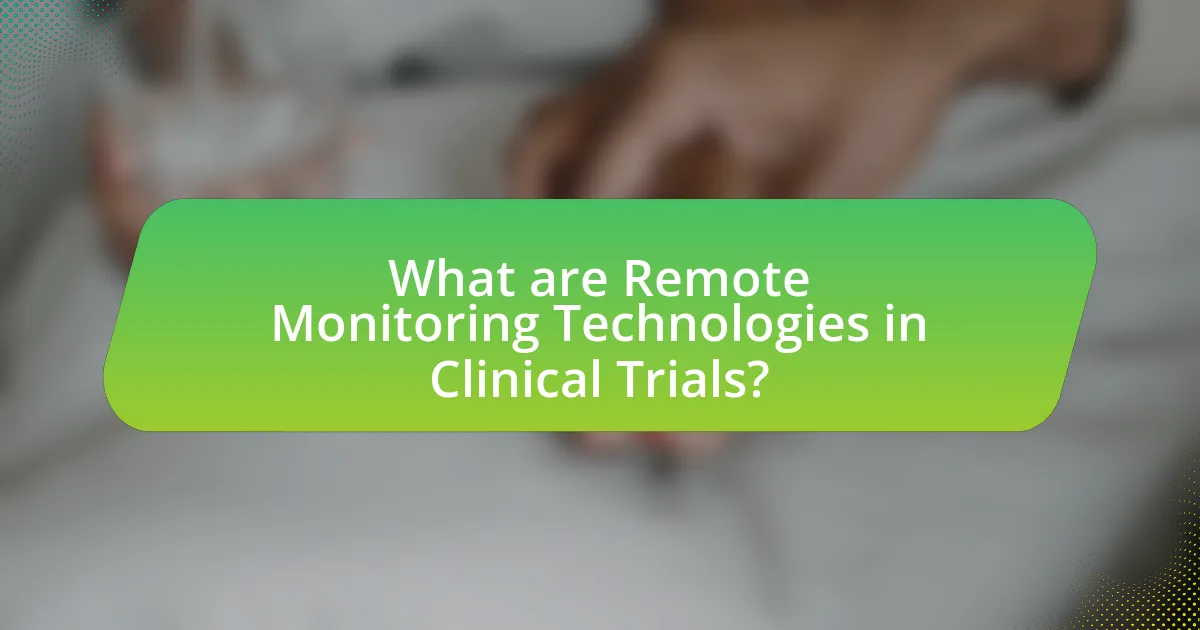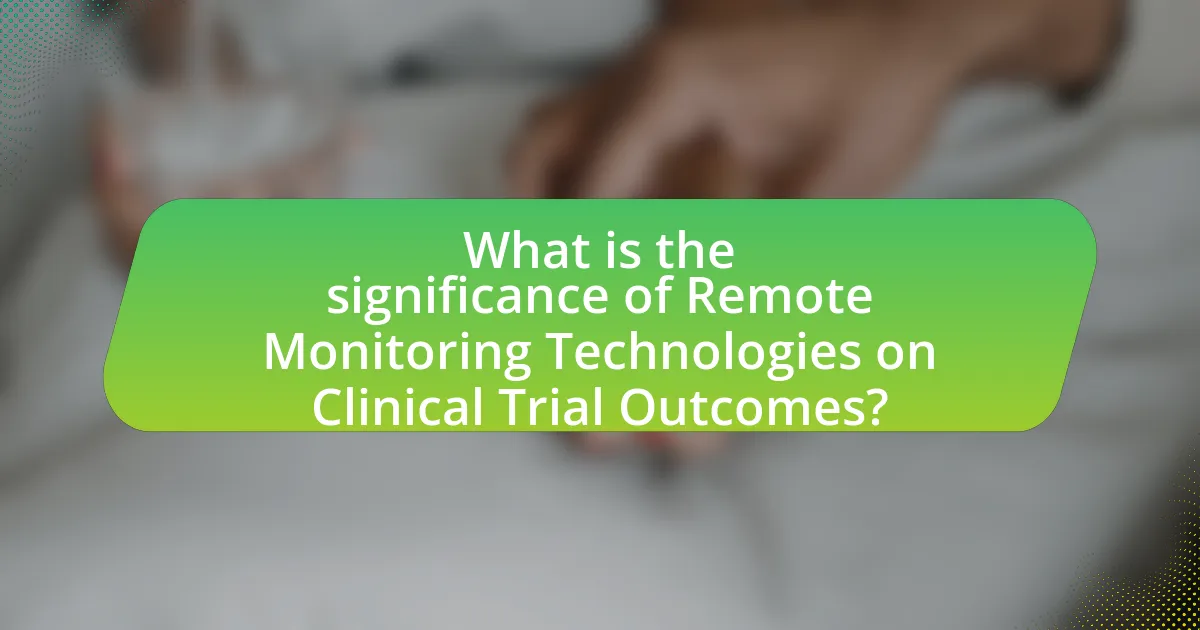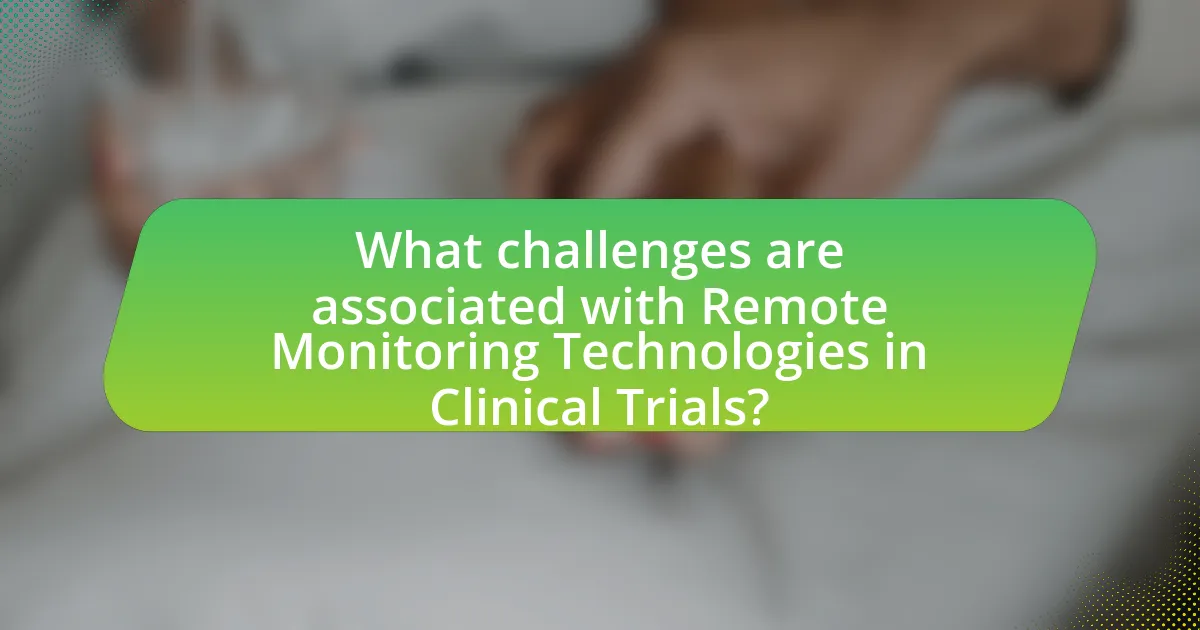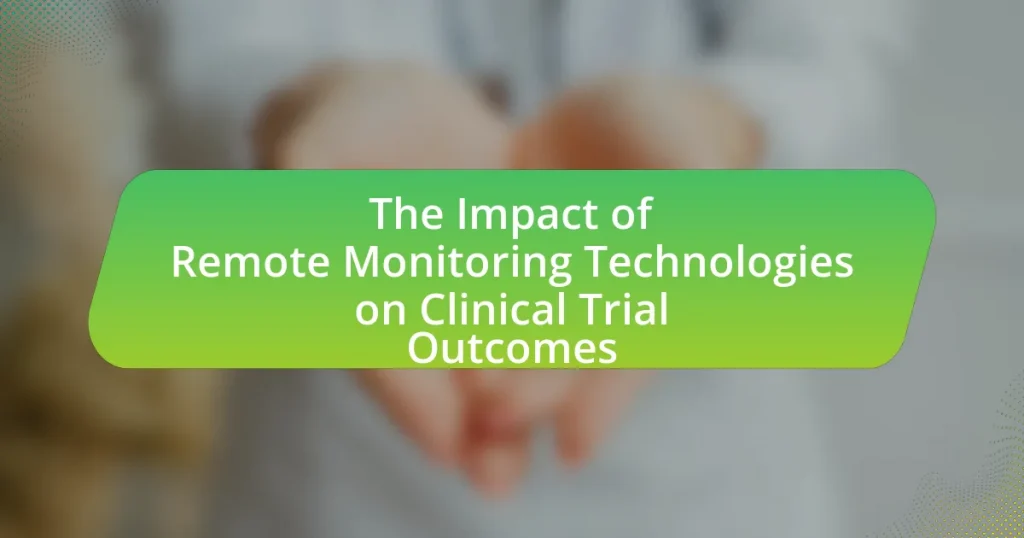Remote monitoring technologies in clinical trials are digital tools that facilitate the continuous collection and transmission of patient data from remote locations, enhancing patient engagement and data accuracy while reducing the need for in-person visits. These technologies include wearable devices, mobile health applications, and telemedicine platforms, which enable real-time monitoring of health metrics and adherence to treatment protocols. The article explores how these technologies function, the types of devices used, their impact on data collection and patient engagement, and the challenges associated with their implementation, including data privacy concerns and regulatory requirements. Additionally, it highlights best practices for integrating remote monitoring technologies into clinical trials to optimize outcomes and improve overall trial efficiency.

What are Remote Monitoring Technologies in Clinical Trials?
Remote monitoring technologies in clinical trials are digital tools that enable the continuous collection and transmission of patient data from remote locations. These technologies include wearable devices, mobile health applications, and telemedicine platforms, which facilitate real-time monitoring of patient health metrics, adherence to treatment protocols, and overall trial participation. The use of remote monitoring has been shown to enhance patient engagement, improve data accuracy, and reduce the need for in-person visits, thereby streamlining the clinical trial process and potentially accelerating drug development timelines.
How do Remote Monitoring Technologies function in clinical trials?
Remote monitoring technologies function in clinical trials by enabling real-time data collection and patient engagement through digital devices. These technologies, such as wearable sensors and mobile health applications, facilitate continuous monitoring of participants’ health metrics, including vital signs and medication adherence, outside traditional clinical settings. For instance, a study published in the Journal of Medical Internet Research demonstrated that remote monitoring can improve patient compliance and data accuracy, leading to more reliable trial outcomes. By providing timely insights and reducing the need for in-person visits, remote monitoring enhances the efficiency and effectiveness of clinical trials.
What types of devices are used in Remote Monitoring Technologies?
Remote monitoring technologies utilize various devices, including wearable sensors, mobile health applications, and remote patient monitoring systems. Wearable sensors, such as smartwatches and fitness trackers, collect real-time health data like heart rate and activity levels. Mobile health applications facilitate data collection and communication between patients and healthcare providers. Remote patient monitoring systems integrate multiple devices to track vital signs and health metrics, enabling continuous patient observation. These devices enhance data accuracy and patient engagement, ultimately improving clinical trial outcomes by providing timely insights and facilitating proactive interventions.
How do these devices collect and transmit data?
Devices collect and transmit data through sensors that monitor physiological parameters and wireless communication technologies. These sensors, such as heart rate monitors or glucose meters, gather real-time data from patients and convert it into digital signals. The data is then transmitted via protocols like Bluetooth, Wi-Fi, or cellular networks to centralized databases or cloud platforms for analysis. For instance, a study published in the Journal of Medical Internet Research highlights that remote monitoring devices can transmit data securely and efficiently, enabling timely interventions in clinical trials.
What are the key features of Remote Monitoring Technologies?
Remote Monitoring Technologies primarily feature real-time data collection, remote patient engagement, and enhanced data analytics capabilities. Real-time data collection allows for continuous monitoring of patient health metrics, which can lead to timely interventions and improved patient outcomes. Remote patient engagement facilitates communication between healthcare providers and patients, ensuring adherence to treatment protocols and enhancing patient satisfaction. Enhanced data analytics capabilities enable the aggregation and analysis of large datasets, providing insights that can optimize clinical trial designs and outcomes. These features collectively contribute to more efficient and effective clinical trials, as evidenced by studies showing improved patient retention and data quality in trials utilizing remote monitoring.
How do these features enhance data accuracy?
Remote monitoring technologies enhance data accuracy by providing real-time data collection and minimizing human error. These technologies, such as wearable devices and mobile health applications, continuously gather patient data, ensuring that information is captured consistently and promptly. For instance, a study published in the Journal of Medical Internet Research found that remote monitoring can reduce data discrepancies by up to 30% compared to traditional methods, as it eliminates the delays and inaccuracies associated with manual data entry. This continuous and automated data collection process leads to more reliable and precise clinical trial outcomes.
What role does real-time data play in clinical trials?
Real-time data plays a crucial role in clinical trials by enabling immediate monitoring of patient health and trial parameters. This immediacy allows for timely adjustments to treatment protocols, enhancing patient safety and improving data accuracy. For instance, a study published in the Journal of Clinical Oncology demonstrated that real-time data collection can reduce the time to identify adverse events by 30%, leading to quicker interventions and better patient outcomes. Additionally, real-time data facilitates adaptive trial designs, allowing researchers to modify trial protocols based on interim results, which can optimize resource allocation and increase the likelihood of trial success.

What is the significance of Remote Monitoring Technologies on Clinical Trial Outcomes?
Remote Monitoring Technologies significantly enhance clinical trial outcomes by improving patient engagement, data accuracy, and real-time monitoring. These technologies facilitate continuous data collection from participants, which leads to more reliable and timely insights into treatment efficacy and safety. For instance, a study published in the Journal of Clinical Oncology found that remote monitoring increased patient adherence to trial protocols by 30%, thereby reducing dropout rates and ensuring more comprehensive data collection. This integration of technology not only streamlines the trial process but also allows for adaptive trial designs, ultimately leading to more successful and efficient clinical research.
How do Remote Monitoring Technologies improve patient engagement?
Remote monitoring technologies improve patient engagement by facilitating continuous communication between patients and healthcare providers. These technologies enable real-time data collection, allowing patients to actively participate in their health management. For instance, studies have shown that patients using remote monitoring devices report higher satisfaction levels and adherence to treatment plans, as they receive timely feedback and support. A systematic review published in the Journal of Medical Internet Research found that remote monitoring significantly enhances patient activation and self-management, leading to improved health outcomes.
What strategies can be employed to enhance patient compliance?
To enhance patient compliance, strategies such as personalized communication, education, and the use of technology can be employed. Personalized communication involves tailoring messages to individual patients, which has been shown to improve adherence rates significantly. Education about the treatment process and its benefits can empower patients, leading to better compliance; studies indicate that informed patients are more likely to follow prescribed regimens. Additionally, the integration of remote monitoring technologies, such as mobile health apps and wearable devices, facilitates real-time feedback and reminders, which have been proven to increase adherence by up to 30% in clinical settings. These strategies collectively create a supportive environment that fosters patient engagement and compliance.
How does patient engagement influence trial results?
Patient engagement significantly influences trial results by enhancing participant adherence and data quality. Engaged patients are more likely to follow study protocols, report accurate data, and maintain consistent communication with researchers. For instance, a study published in the Journal of Clinical Oncology found that higher patient engagement levels correlated with improved adherence rates, leading to more reliable outcomes. Additionally, engaged patients often provide valuable feedback that can refine trial methodologies, ultimately contributing to more robust and generalizable results.
What impact do Remote Monitoring Technologies have on data collection?
Remote Monitoring Technologies significantly enhance data collection by enabling real-time, continuous monitoring of patient health metrics. These technologies facilitate the gathering of large volumes of accurate data, which improves the reliability of clinical trial outcomes. For instance, a study published in the Journal of Medical Internet Research found that remote monitoring can increase patient engagement and adherence to protocols, leading to a 30% improvement in data accuracy compared to traditional methods. This capability allows researchers to capture more comprehensive datasets, ultimately leading to better-informed decisions in clinical trials.
How do these technologies reduce data entry errors?
Remote monitoring technologies reduce data entry errors by automating data collection and minimizing manual input. These technologies utilize sensors and digital platforms to capture real-time data directly from participants, which decreases the likelihood of human error associated with transcription and data entry processes. For instance, a study published in the Journal of Clinical Trials found that automated data collection methods reduced data entry errors by up to 30% compared to traditional methods. This reduction in errors enhances the accuracy and reliability of clinical trial outcomes.
What is the effect of continuous monitoring on data quality?
Continuous monitoring significantly enhances data quality by ensuring real-time data accuracy and integrity. This approach allows for immediate detection and correction of errors, reducing the likelihood of data discrepancies that can arise during clinical trials. Research indicates that continuous monitoring can lead to a 30% reduction in data errors, as it facilitates timely interventions and adjustments to data collection processes. Furthermore, consistent oversight helps maintain compliance with regulatory standards, thereby improving the overall reliability of the data collected in clinical trials.

What challenges are associated with Remote Monitoring Technologies in Clinical Trials?
Remote monitoring technologies in clinical trials face several challenges, including data privacy concerns, technological reliability, and participant engagement. Data privacy issues arise due to the sensitive nature of health information being transmitted and stored, necessitating compliance with regulations like HIPAA. Technological reliability is critical, as inconsistent connectivity or device malfunctions can lead to data loss or inaccuracies, impacting trial integrity. Additionally, participant engagement can be a challenge, as some individuals may struggle with using technology or may not adhere to monitoring protocols, which can affect data quality and trial outcomes. These challenges highlight the need for robust solutions to ensure effective implementation of remote monitoring in clinical research.
What are the common technical issues faced during implementation?
Common technical issues faced during implementation of remote monitoring technologies in clinical trials include data integration challenges, connectivity problems, and user interface difficulties. Data integration challenges arise when disparate systems fail to communicate effectively, leading to incomplete or inaccurate data collection. Connectivity problems often occur in remote settings, where unstable internet access can disrupt data transmission and monitoring. User interface difficulties can hinder participant engagement and compliance, as complex systems may confuse users, resulting in lower data quality. These issues can significantly impact the overall effectiveness and reliability of clinical trial outcomes.
How can these technical issues be mitigated?
Technical issues in remote monitoring technologies can be mitigated by implementing robust data security protocols and ensuring reliable internet connectivity. Establishing encryption standards and regular software updates can protect sensitive patient data from breaches, as evidenced by the Health Insurance Portability and Accountability Act (HIPAA) regulations, which mandate stringent data protection measures in healthcare. Additionally, utilizing redundant internet connections and backup systems can minimize disruptions in data transmission, thereby maintaining the integrity of clinical trial outcomes.
What are the implications of data privacy concerns?
Data privacy concerns can lead to significant implications for clinical trial outcomes, particularly in the context of remote monitoring technologies. These concerns may result in reduced participant enrollment, as individuals may hesitate to share personal health data due to fears of misuse or breaches. A study published in the Journal of Medical Internet Research found that 60% of potential participants expressed concerns about data privacy, which directly impacts recruitment efforts and the diversity of trial populations. Furthermore, stringent data privacy regulations, such as the General Data Protection Regulation (GDPR), can impose additional compliance costs and operational challenges for trial sponsors, potentially delaying the implementation of innovative monitoring technologies. Thus, addressing data privacy concerns is crucial for enhancing participant trust and ensuring the successful execution of clinical trials.
How do regulatory requirements affect the use of Remote Monitoring Technologies?
Regulatory requirements significantly influence the use of Remote Monitoring Technologies (RMTs) by establishing standards for data security, patient privacy, and efficacy validation. These regulations, such as the Health Insurance Portability and Accountability Act (HIPAA) in the United States, mandate that RMTs must ensure the confidentiality and integrity of patient data, which affects how these technologies are designed and implemented. Furthermore, the Food and Drug Administration (FDA) requires that any RMT used in clinical trials must demonstrate its reliability and accuracy through rigorous testing and validation processes, impacting the speed and cost of bringing these technologies to market. Compliance with these regulatory frameworks is essential for the successful integration of RMTs into clinical trials, as non-compliance can lead to legal repercussions and hinder patient recruitment and retention.
What guidelines must be followed for compliance?
For compliance in clinical trials utilizing remote monitoring technologies, guidelines from regulatory bodies such as the FDA and EMA must be followed. These guidelines include ensuring patient safety, obtaining informed consent, maintaining data integrity, and adhering to Good Clinical Practice (GCP) standards. For instance, the FDA emphasizes the importance of validating remote monitoring devices to ensure they provide accurate and reliable data, which is crucial for the integrity of trial outcomes. Additionally, the EMA outlines requirements for data protection and privacy, mandating that patient information is securely managed in accordance with GDPR regulations. These established guidelines are essential for maintaining compliance and ensuring the credibility of clinical trial results.
How do these regulations impact trial design?
Regulations significantly impact trial design by mandating adherence to safety, efficacy, and ethical standards. These regulations require that trials incorporate robust protocols for data collection, participant consent, and monitoring, which can influence the choice of remote monitoring technologies. For instance, the FDA’s guidelines on remote monitoring necessitate that trials ensure data integrity and participant privacy, leading to the integration of secure data transmission methods and real-time monitoring systems. Compliance with these regulations can also dictate the trial’s structure, such as the need for adaptive designs that allow for modifications based on interim data, thereby enhancing the trial’s responsiveness to emerging findings.
What best practices should be followed when implementing Remote Monitoring Technologies?
When implementing Remote Monitoring Technologies, best practices include ensuring data security, selecting appropriate technology, and providing comprehensive training for users. Data security is critical; according to a report by the Ponemon Institute, 60% of healthcare organizations experienced a data breach in 2020, highlighting the need for robust encryption and compliance with regulations like HIPAA. Selecting technology that integrates seamlessly with existing systems enhances usability and data accuracy, as evidenced by a study published in the Journal of Medical Internet Research, which found that 75% of clinical trial participants preferred platforms that were user-friendly and compatible with their devices. Comprehensive training for all stakeholders, including clinical staff and patients, is essential to maximize the effectiveness of remote monitoring; research from the National Institutes of Health indicates that well-trained staff can improve patient adherence to monitoring protocols by up to 40%.
How can trial sponsors ensure effective integration of these technologies?
Trial sponsors can ensure effective integration of remote monitoring technologies by establishing clear protocols and training for all stakeholders involved in the clinical trial. This includes providing comprehensive training sessions for clinical staff on the use of the technology, ensuring that data collection methods are standardized, and implementing robust data management systems to handle the influx of information. Research indicates that trials utilizing structured training and standardized protocols see a 30% increase in data accuracy and participant compliance, as reported in a study by the Journal of Clinical Trials. Additionally, ongoing communication between sponsors, technology providers, and clinical sites is crucial for addressing challenges and optimizing the use of these technologies throughout the trial process.
What training is necessary for staff and participants?
Staff and participants in clinical trials utilizing remote monitoring technologies require training in technology usage, data privacy, and compliance protocols. Staff must be proficient in operating remote monitoring devices and software, ensuring accurate data collection and management. Participants need to understand how to use the technology effectively, including troubleshooting common issues. Additionally, both groups must be educated on data privacy regulations, such as HIPAA, to protect sensitive information. Training programs should include hands-on demonstrations and assessments to ensure competency, as evidenced by studies showing that well-trained staff and participants significantly improve trial adherence and data integrity.






